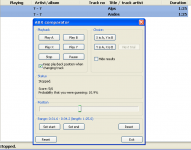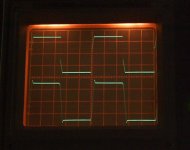This is the further test that I mentioned HERE
In many ways this test could be the most relevant to many of the discussions that come up in small signal audio design and so it would be great to have your impressions on this one.
Two files,
ANDES
ALPS
This test really is important to me and seeing the results of any ABX tests.
In many ways this test could be the most relevant to many of the discussions that come up in small signal audio design and so it would be great to have your impressions on this one.
Two files,
ANDES
ALPS
This test really is important to me and seeing the results of any ABX tests.
One quite definite result has come in to me via pm describing a difference that was identifiable by the listener.
For those of you using foobar it would be great to see your ABX results too. Lets make this one count.
Mooley!! Don't you get IT?
Already you have scuppered the objectivity of your test by declaring (in 20 minutes of the posting
 ) that there is a "definite identifiable difference".
) that there is a "definite identifiable difference".All a waste of time. Pity. I endorse your motives.
All a waste of time. Pity. I endorse your motives.
This is ABX, so no problem. I even have not read what you are quoting.
Thank you, great test! I have just sent you an e-mail.
Got it. Thanks. I will study it tomorrow. Very interesting indeed. It may go some way to answering a question that crops up in small signal design.
This test was not easy, I had to make several breaks, took headphones down from my head and relaxed before next trial. It needed great concentration, at least for me.
That's good and in a way I'm pleased because I think you might be surprised what the difference in hardware really is on this one. It goes some way to laying to rest a "nagging doubt" and "audio myth"
(I'm going to look at the FFT now and listen to you know what
I have learned a lot during these ABX tests. 1st, I have learned how to LISTEN in ABX. It needs different listening behavior compared to in-room listening. No wonder that random collection of listeners found in the street has no results. 2nd, the differences that are often overlooked and trivialized may be proven by ABX. 3rd, human hearing abilities differ 
Mostly phase shifts again (the phase shifts of the 2 chains under test do exist). Even small phase shifts, frequency dependent phase shifts, result in not small differences in the difference file.
This opens another interesting point. My opinion, that I keep for years, is such that we may not divide non-linear (harmonic) from linear distortion. So, I do not take into account the tests that equalize frequency responses (LP and HP filters insertion) of both test channels before testing. I find such manipulation as illegal and not proven as inaudible.
This opens another interesting point. My opinion, that I keep for years, is such that we may not divide non-linear (harmonic) from linear distortion. So, I do not take into account the tests that equalize frequency responses (LP and HP filters insertion) of both test channels before testing. I find such manipulation as illegal and not proven as inaudible.
There was no cap of any form (beside strays) in the audio path.
That's fine, but even possible DC coupled hardware circuit will introduce frequency dependent phase shifts due to its own high frequency roll-off. This is to explain the difference spectrum. Regarding audibility, I am not sure, but probably a combination of both linear and non-linear distortions makes the audible discernible (though not easily) difference.
Sine testing shows no real phase shift at all even out to 100kHz.
Squarewave testing shows an expected and little commented on "effect". Top trace is the input to the test circuit (6 volts pk/pk). Notice how the input to the test circuit is actually distorted. That is caused by the non linear loading of the input stage of the test circuit hardware. This effect only becomes apparent above around 1.8 volts pk/pk input levels. The signal source is a 50 ohm generator so that effect is pretty severe to do that. Its an effect thats easily fixed but could we argue its audible as it stands ?
Squarewave testing shows an expected and little commented on "effect". Top trace is the input to the test circuit (6 volts pk/pk). Notice how the input to the test circuit is actually distorted. That is caused by the non linear loading of the input stage of the test circuit hardware. This effect only becomes apparent above around 1.8 volts pk/pk input levels. The signal source is a 50 ohm generator so that effect is pretty severe to do that. Its an effect thats easily fixed but could we argue its audible as it stands ?
Attachments
- Status
- This old topic is closed. If you want to reopen this topic, contact a moderator using the "Report Post" button.
- Home
- General Interest
- Everything Else
- Small Signal Listening Comparison Test

